
Ulithi is an atoll in the Caroline Islands of the western Pacific Ocean, about 191 km (103 nmi) east of Yap, within Yap State.
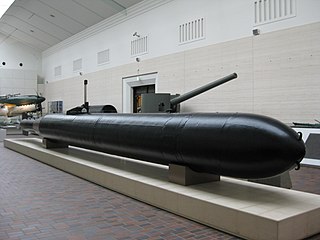
Kaiten were crewed torpedoes and suicide craft, used by the Imperial Japanese Navy in the final stages of World War II.

I-58 was a Japanese B3 type cruiser submarine that served in the final year of World War II. Her only significant wartime success came with a conventional torpedo attack upon USS Indianapolis on 30 July 1945. She was modified to carry Kaiten manned torpedoes, making several attacks that inflicted minor damage in exchange for every Kaiten launched being sunk. The submarine surrendered in September 1945, and was later scuttled by the United States Navy.
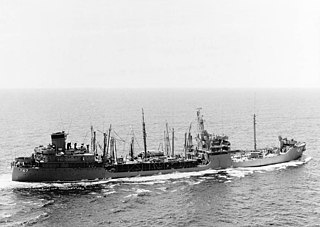
USS Neches (AO-47) was a Kennebec-class oiler in the United States Navy during World War II and the Vietnam War. She was the second U.S. Navy ship named for the Neches River in eastern Texas.

USS Tappahannock (AO-43) was a Kennebec-class oiler in the United States Navy that served during World War II, the Korean War, and the Vietnam War. She was sold for scrap in 1987.

USS Tallulah (AO-50), originally named the SS Valley Forge, was a Type T2-SE-A1 Suamico-class fleet oiler of the United States Navy.

USS Schuylkill (AO-76), originally named the SS Louisburg, was a Type T2-SE-A1 Suamico-class fleet oiler of the United States Navy.

The USS Manatee (AO-58)—the second vessel of the United States Navy to bear the name—was a Cimarron-class fleet replenishment oiler named for a river in Florida. Cimarron-class oilers were named after American rivers in the southern United States.

USS Soubarissen (AO-93) was an Escambia-class fleet oiler converted to a water tanker, named for a chief of the "Neutral" Indian Nations which, although a part of the Iroquois confederation, were called "neutral" by the French because they took no part in the wars of the Iroquois and Hurons. The area he governed included the oil fields of northwestern Pennsylvania and western New York. The knowledge of the oil seepages there was well known among the Indians, and it was declared neutral ground so all Indians could obtain oil for medicinal and domestic purposes without danger or interference. In 1627, Joseph de La Roche Daillon heard of the oil springs and made an expedition to visit them. He was kindly received by Chief Soubarissen, shown the oil seepages, and duly reported his observations to his superiors. These observations contributed largely to the interest in the petroleum resources of the Pennsylvania region.

A Service Squadron (ServRon) was a United States Navy squadron that supported fleet combat ships and US Navy Auxiliary ships. Service Squadrons were used by the US Navy from their inception in 1943 to as late as the early 1980s. At the time of their inception during the Second World War they allowed the US Navy to operate across the vast reaches of the Pacific Ocean for extended periods of time. Service Squadrons created temporary forward bases to allow the naval squadrons to spend less time in transit and more time in the area of combat. Ulithi, a small volcanic atoll in the central Pacific, is an example of a site converted for use as a forward base of supply. Service Squadrons essentially created a major naval base near the area of operation. With naval bases like, Naval Base Ulithi, to refit, repair and resupply, many ships were able to deploy and operate in the western Pacific for a year or more without returning to a major port facility. Among the vessels operating in service squadrons were tankers, Fleet oilers, refrigerator ships, ammunition ships, supply ships, floating docks and repair ships. They provided diesel, ordnance, aviation fuel, food stuffs and all other supplies. Equally important at places like Ulithi were the portable piers and floating dry docks which allowed many ships damaged by enemy action or Pacific storms to undergo repair without having to travel the thousands of miles back to a major US naval base. Ulithi was as far forward from the US naval base at San Francisco as the San Francisco base was from London, England. To have a fully functional major port in the middle of the Pacific was a significant aid to U.S. Navy operations.

USS Rall (DE-304) was an Evarts-class destroyer escort of the United States Navy during World War II. She was sent off into the Pacific Ocean to protect convoys and other ships from Japanese submarines and fighter aircraft. She performed escort and anti-submarine operations in dangerous battle areas and returned home with three battle stars.

USS Caliente (AO-53) was a Cimarron-class fleet oiler built during World War II for the U.S. Navy. During her career in the Pacific Ocean, Caliente participated in World War II, the Korean War, and the Vietnam War. She was highly decorated for fulfilling her dangerous mission of carrying fuel into battle areas. She received ten battle stars for World War II, four for the Korean War and eight campaign stars for the Vietnam War.

USS Mascoma (AO-83) was a Escambia-class replenishment oiler constructed for the United States Navy during World War II. She served her country in the Pacific Ocean Theatre of Operations, and provided petroleum products where needed to combat ships. For her very dangerous work under combat conditions, she was awarded seven battle stars by war's end.
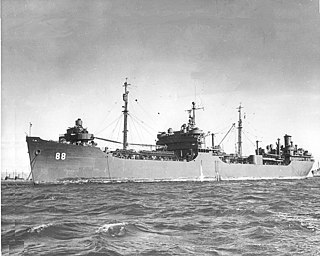
USS Tomahawk (AO-88) was an Escambia-class fleet oiler acquired by the United States Navy for use during World War II. She had the dangerous but necessary task of providing fuel to vessels in combat and non-combat areas primarily in the Pacific Ocean. For her valiant efforts, she received six battle stars during the war.

USS Sebec (AO-87) was a Escambia-class fleet oiler acquired by the United States Navy for use during World War II. She had the dangerous but necessary task of providing fuel to vessels in combat and non-combat areas primarily in the Pacific Ocean. For her valiant efforts, she received six battle stars during the war.
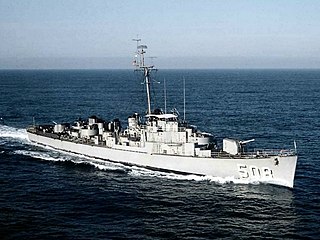
USS Gilligan (DE-508) was a John C. Butler-class destroyer escort acquired by the U.S. Navy during World War II. The primary purpose of the destroyer escort was to escort and protect ships in convoy, in addition to other tasks as assigned, such as patrol or radar picket. After the war, she returned home with one battle star to her credit.

The T3 tanker, or T3, are a class of seaworthy large tanker ships produced in the United States and used to transport fuel oil, gasoline or diesel before and during World War II, the Korean War and the Vietnam War. The T3 tanker classification is still used today. The T3 tanker has a full load displacement of about 24,830 tons.

I-47 was the second of three Type C cruiser submarines of the C2 sub-class built for the Imperial Japanese Navy. Commissioned in July 1944, she operated as a kaiten manned suicide attack torpedo carrier during the final year of World War II. Surrendered at the end of the war, she was scuttled by the United States Navy in 1946.
I-36 was an Imperial Japanese Navy B1 type submarine. Completed and commissioned in 1942, she served in World War II, operating in the Guadalcanal campaign, New Guinea campaign, Aleutian Islands campaign, and the Marshall Islands. She finished the war as a kaiten manned suicide attack torpedo carrier, operating against Allied ships at Ulithi Atoll and in the Philippine Sea. The only submarine of her class to survive the war, she surrendered to the Allies in September 1945 after the end of the war and was scuttled by the United States Navy in 1946.
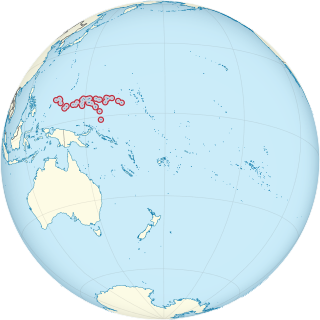
Naval Base Ulithi was a major United States Navy base at the Ulithi Atoll in the Caroline Islands in the western Pacific Ocean, to the north of New Guinea during World War II. The base was built to support the island-hopping Pacific war efforts of the Allied nations fighting the Empire of Japan. In terms of the number of ships at one base, Naval Base Ulithi was the largest naval base in the world in 1944 and 1945, with over 600 ships at times.






















